Themed collection Pioneering Investigators

Pioneering Investigators 2017
This themed issue of Polymer Chemistry highlights the work of pioneering investigators in the polymer chemistry field. Associate Editors Emily Pentzer and Eva Harth introduce the issue.

Polym. Chem., 2017,8, 4904-4915
https://doi.org/10.1039/C7PY90121F
Ring-expansion cationic polymerization of vinyl ethers
Ring-expansion cationic polymerization of vinyl ethers with a hemiacetal ester-embedded cyclic initiator allows precise syntheses of ring-based architectures due to the controlled propagation as well as the monomer pendant design.
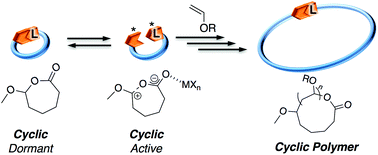
Polym. Chem., 2017,8, 4970-4977
https://doi.org/10.1039/C7PY00638A
Multicellular tumor spheroids: a relevant 3D model for the in vitro preclinical investigation of polymer nanomedicines
Application of 3D multicellular tumor spheroids to the investigation of polymer nanomedicines.

Polym. Chem., 2017,8, 4947-4969
https://doi.org/10.1039/C7PY00559H
Opportunities for dual RDRP agents in synthesizing novel polymeric materials
Dual RDRP agents provide access to new polymeric materials by combining ATRP, NMP, and RAFT polymerization without end group transformations.
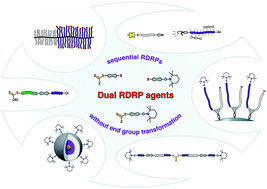
Polym. Chem., 2017,8, 4916-4946
https://doi.org/10.1039/C7PY00344G
Facile thiolation of hydroxyl functional polymers
A simple synthetic pathway to broaden the accessibility of thiol-functional polymers including formation of dendritic hydrogels via TEC chemistry.

Polym. Chem., 2017,8, 4996-5001
https://doi.org/10.1039/C7PY01097D
Water-based acrylic coatings reinforced by PISA-derived fibers
Polymerization-induced self-assembly (PISA) provides nanofibers that may be used as reinforcing fillers for all-organic aqueous coatings.

Polym. Chem., 2017,8, 4992-4995
https://doi.org/10.1039/C7PY00302A
Sequence-coded ATRP macroinitiators
Sequence-defined oligourethanes were transformed into ATRP initiators and used for the synthesis of precision macromolecular architectures.
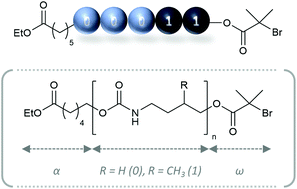
Polym. Chem., 2017,8, 4988-4991
https://doi.org/10.1039/C7PY00496F
Poly(N-(2-hydroxypropyl)methacrylamide)–valproic acid conjugates as block copolymer nanocarriers
We report nanoassemblies based on block copolymers of N-(2-hydroxypropyl)methacrylamide (HPMA) in which drug cleavage enhances the biological compatibility of the original polymer carrier by regeneration of HPMA units.

Polym. Chem., 2017,8, 4983-4987
https://doi.org/10.1039/C7PY00196G
Aqueous RAFT at pH zero: enabling controlled polymerization of unprotected acyl hydrazide methacrylamides
A first example of controlled radical polymerization of monomers containing unprotected acyl hydrazide pendent groups was demonstrated using aqueous RAFT polymerization at pH = 0.

Polym. Chem., 2017,8, 4978-4982
https://doi.org/10.1039/C6PY01563H
Anti-protein and anti-bacterial behavior of amphiphilic silicones
Silicones bulk-modified with various PEO-silane amphiphiles were demonstrated to be resistant to plasma proteins, several bacteria, and a fungus.
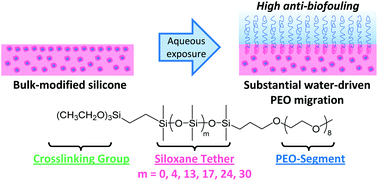
Polym. Chem., 2017,8, 5239-5251
https://doi.org/10.1039/C7PY00944E
Synthesis of molecular brushes by telomerization
This work reports the straightforward synthesis of molecular brushes by telomerization from polythiol multifunctional macrotransfer agents.

Polym. Chem., 2017,8, 5220-5227
https://doi.org/10.1039/C7PY00875A
Introduction of anti-fouling coatings at the surface of supramolecular elastomeric materials via post-modification of reactive supramolecular additives
A covalent anti-fouling is introduced at the surface of supramolecular ureidopyrimidinone (UPy) based materials to prevent both protein and cell adhesion.

Polym. Chem., 2017,8, 5228-5238
https://doi.org/10.1039/C7PY00801E
Enzyme-targeted nanoparticles for delivery to ischemic skeletal muscle
In this study, we show for the first time enzyme-directed assembly of intravenously (IV) delivered nanoparticles in ischemic skeletal muscle, which has applications for drug delivery to damaged muscle of the type prevalent in peripheral artery disease (PAD).
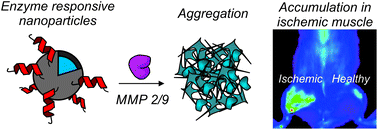
Polym. Chem., 2017,8, 5212-5219
https://doi.org/10.1039/C7PY00568G
Self-assembly of poly(vinylidene fluoride)-block-poly(2-(dimethylamino)ethylmethacrylate) block copolymers prepared by CuAAC click coupling
Self-assembly of PDMAEMA-b-PVDF block copolymers.
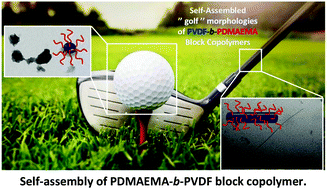
Polym. Chem., 2017,8, 5203-5211
https://doi.org/10.1039/C7PY00346C
An indacenodithiophene-based semiconducting polymer with high ductility for stretchable organic electronics
An alkyl-substituted indacenodithiophene-based donor–acceptor π-conjugated polymer (PIDTBPD) with low stiffness and high ductility is reported.

Polym. Chem., 2017,8, 5185-5193
https://doi.org/10.1039/C7PY00435D
A study of fused-ring thieno[3,4-e]pyrazine polymers as n-type materials for organic supercapacitors
Conjugated polymer pseudocapacitors achieve high capacitances because they store charge through fast, reversible redox reactions.
![Graphical abstract: A study of fused-ring thieno[3,4-e]pyrazine polymers as n-type materials for organic supercapacitors](/is/Image/Get?imageInfo.ImageType=GA&imageInfo.ImageIdentifier.ManuscriptID=C7PY00512A&imageInfo.ImageIdentifier.Year=2017)
Polym. Chem., 2017,8, 5194-5202
https://doi.org/10.1039/C7PY00512A
Switchable 19F MRI polymer theranostics: towards in situ quantifiable drug release
A switchable polymeric 19F magnetic resonance imaging (MRI) contrast agent was synthesised whereby the transverse (T2) relaxation times increased as a therapeutic was released from a hyperbranched polymer (HBP) scaffold.

Polym. Chem., 2017,8, 5157-5166
https://doi.org/10.1039/C7PY00345E
Structure–cytotoxicity relationship of drug-initiated polymer prodrug nanoparticles
Cladribine (CdA)-based polymer prodrug nanoparticles were obtained by “drug-initiated” RAFT polymerization of squalenyl methacrylate (SqMA) from two different CdA-bearing chain transfer agents (CTAs) to evaluate the influence of the nature of the linkage between CdA and the CTA, and the bulkiness of the polymer, on the drug release and the biological performance.

Polym. Chem., 2017,8, 5174-5184
https://doi.org/10.1039/C7PY00536A
Thermosensitive spontaneous gradient copolymers with block- and gradient-like features
Amphiphilic gradient copolymers with thermoresponsive properties were synthesized in one pot via RAFT copolymerization.

Polym. Chem., 2017,8, 5023-5032
https://doi.org/10.1039/C7PY00495H
Chalcogenide hybrid inorganic/organic polymers (CHIPs) via inverse vulcanization and dynamic covalent polymerizations
Poly(sulfur-random-styrene) was made via inverse vulcanization and used for dynamic covalent copolymerization (DCP) to incorporate novel vinylic monomers.
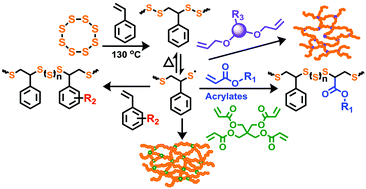
Polym. Chem., 2017,8, 5167-5173
https://doi.org/10.1039/C7PY00587C
Hollow amphiphilic crosslinked nanocapsules from sacrificial silica nanoparticle templates and their application as dispersants for oil spill remediation
Hollow nanocapsules were constructed using a sacrificial silica scaffold to produce novel oil remediation agents.
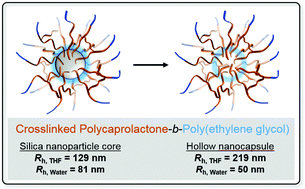
Polym. Chem., 2017,8, 5129-5138
https://doi.org/10.1039/C7PY00342K
Norbornene-modified poly(glycerol sebacate) as a photocurable and biodegradable elastomer
Photocurable norbornene-functionalized poly(glycerol sebacate) (Nor-PGS) has been developed to fabricate cytocompatible, biodegradable and elastomeric scaffolds for tissue engineering applications.

Polym. Chem., 2017,8, 5091-5099
https://doi.org/10.1039/C7PY00323D
1,2,3-Triazolium-based linear ionic polyurethanes
We report the synthesis and detailed characterization of a series of ionic polyurethanes issued from the polyaddition of a 1,2,3-triazolium-functionalized diol monomer having a bis(trifluoromethylsulfonyl)imide counter-anion with four aliphatic, cycloaliphatic or aromatic commercial diisocyanates.
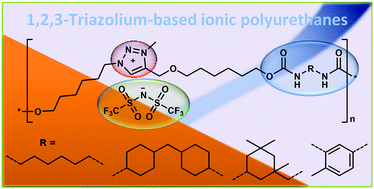
Polym. Chem., 2017,8, 5148-5156
https://doi.org/10.1039/C7PY00406K
A comprehensive kinetic study of the conventional free-radical polymerization of seven-membered cyclic ketene acetals
The current study reports on the kinetic analysis of the free-radical polymerization of several seven-membered cyclic ketene acetal monomers.

Polym. Chem., 2017,8, 5139-5147
https://doi.org/10.1039/C7PY00337D
A mechanistic investigation of Pickering emulsion polymerization
Unravelling the mechanism of Pickering emulsion polymerization using silica nanoparticles as the stabilizer.

Polym. Chem., 2017,8, 5100-5111
https://doi.org/10.1039/C7PY00308K
Exploring structural effects in single-chain “folding” mediated by intramolecular thermal Diels–Alder chemistry
We describe a method to fold single polymer chains into nanoparticles using simple thermal Diels–Alder (DA) chemistry.
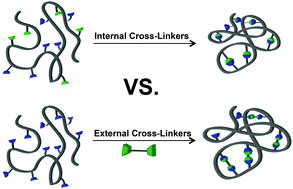
Polym. Chem., 2017,8, 5120-5128
https://doi.org/10.1039/C7PY00320J
Preparation of polythiophene microrods with ordered chain alignment using nanoporous coordination template
The properties of polymeric materials can be amplified by macromolecular alignment.
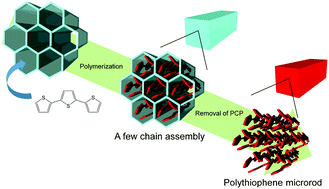
Polym. Chem., 2017,8, 5077-5081
https://doi.org/10.1039/C7PY00309A
Ethylene polymerization catalyzed by dinickel complexes with a double-decker structure
Double-decker dinickel catalysts, even without any substituent on an ortho-position, afforded high molecular weight polyethylene with high crystallinity and less branching.

Polym. Chem., 2017,8, 5112-5119
https://doi.org/10.1039/C7PY00333A
Synthesis of aliphatic polycarbonates with a tuneable thermal response
The synthesis of aliphatic polycarbonates with a tuneable thermal-response is reported by a ‘click-and mix’ approach.
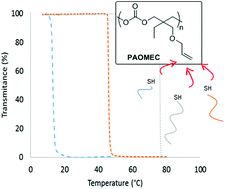
Polym. Chem., 2017,8, 5082-5090
https://doi.org/10.1039/C7PY00358G
Sustainable polyvinyl acetals from bioaromatic aldehydes
Water-degradable polyvinyl acetals with high glass transition temperatures (114–157 °C) were made via acetalization of polyvinyl alcohol (PVA) with bioaromatic aldehydes.
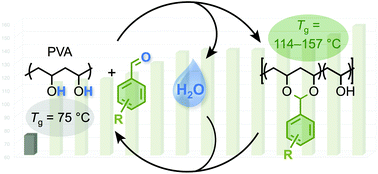
Polym. Chem., 2017,8, 5049-5059
https://doi.org/10.1039/C7PY00205J
The hydrolytic behavior of N,N′-(dimethylamino)ethyl acrylate-functionalized polymeric stars
Well-defined N,N′-(dimethylamino)ethyl acrylate (DMAEA) functionalized polymeric stars have been synthesized via an arm-first approach.

Polym. Chem., 2017,8, 5060-5070
https://doi.org/10.1039/C7PY00219J
Improving tumor chemotherapy effect using an injectable self-healing hydrogel as drug carrier
A self-healing hydrogel has been used as the anti-tumor drug carrier to improve the chemotherapy effect.
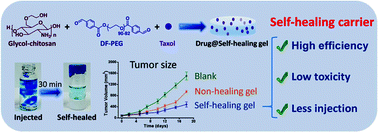
Polym. Chem., 2017,8, 5071-5076
https://doi.org/10.1039/C7PY00112F
One-shot controlled/living copolymerization for various comonomer sequence distributions via dual radical and cationic active species from RAFT terminals
One-shot control of comonomer sequence distributions was demonstrated by dual radical and cationic copolymerization using RAFT mediator.

Polym. Chem., 2017,8, 5002-5011
https://doi.org/10.1039/C7PY00324B
Shape memory polymer foams prepared from a heparin-inspired polyurethane/urea
Shape memory foams have been prepared using a heparin-inspired polyurea/urethane that displays excellent resistance to platelet adherence.

Polym. Chem., 2017,8, 5039-5048
https://doi.org/10.1039/C7PY00204A
Oxygen tolerant photopolymerization for ultralow volumes
A benchtop approach is developed for the synthesis of various polymeric architectures using an aqueous Reversible Addition–Fragmentation chain Transfer (RAFT) photopolymerization technique.
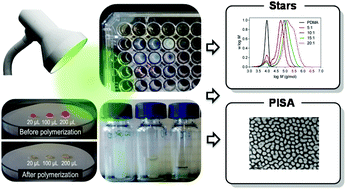
Polym. Chem., 2017,8, 5012-5022
https://doi.org/10.1039/C7PY00007C
Poly(glycerol sebacate) nanoparticles for encapsulation of hydrophobic anti-cancer drugs
Physical encapsulation of hydrophobic compounds into nanocarriers that are stable in aqueous medium is of high interest as it can increase solubilization of the drug, lower its toxicity, control its pharmacokinetic profile and thus overall improve the therapeutic efficacy.
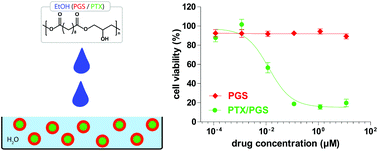
Polym. Chem., 2017,8, 5033-5038
https://doi.org/10.1039/C6PY02192A